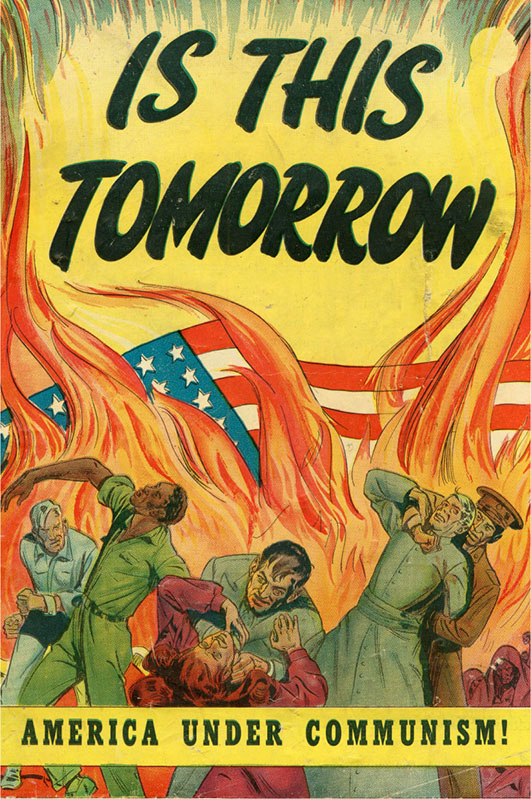Module 12: Post-War Prosperity and Cold War Fears, 1945-1960
Section outline
-
 Image from Chapter 28 of U.S. History (opens in new window) from OpenStax, licensed under Creative Commons Attribution License v4.0 with the image information: Is This Tomorrow? warned Americans about the potential horrors of living under a Communist dictatorship. Postwar propaganda such as this comic book, the cover of which showed invading Russians attacking Americans and the U.S. flag in flames, served to drum up fear during the Cold War.This module explores the post World War II United States. At the end of World War II, U.S. servicemen and women returned and all hoped the prosperity of the war years would continue but marginalized groups did not share in this prosperity. Joy at the ending of World War II was replaced by fears of conflict with the Soviet Union. Young Americans married in record numbers, moved to the growing suburbs, and gave birth to the largest generation to date in U.S. history. Young Americans in the postwar period had more disposable income and enjoyed greater material comfort than their parents. This allowed them to devote more time and money to the consumption of popular culture. After World War II, African American efforts to secure greater civil rights increased across the United States.Upon completion of this module, you will be able to:
Image from Chapter 28 of U.S. History (opens in new window) from OpenStax, licensed under Creative Commons Attribution License v4.0 with the image information: Is This Tomorrow? warned Americans about the potential horrors of living under a Communist dictatorship. Postwar propaganda such as this comic book, the cover of which showed invading Russians attacking Americans and the U.S. flag in flames, served to drum up fear during the Cold War.This module explores the post World War II United States. At the end of World War II, U.S. servicemen and women returned and all hoped the prosperity of the war years would continue but marginalized groups did not share in this prosperity. Joy at the ending of World War II was replaced by fears of conflict with the Soviet Union. Young Americans married in record numbers, moved to the growing suburbs, and gave birth to the largest generation to date in U.S. history. Young Americans in the postwar period had more disposable income and enjoyed greater material comfort than their parents. This allowed them to devote more time and money to the consumption of popular culture. After World War II, African American efforts to secure greater civil rights increased across the United States.Upon completion of this module, you will be able to:- Identify the issues that the nation faced during demobilization (CO 1-3)
- Explain the goals and objectives of the Truman administration (CO 1-3)
- Evaluate the actions taken by the U.S. government to address the concerns of returning veterans (CO 1-3)
- Explain how and why the Cold War emerged in the wake of World War II (CO 1-4)
- Describe the steps taken by the U.S. government to oppose Communist expansion in Europe and Asia (CO 1-4)
- Discuss the government’s efforts to root out Communist influences in the United States (CO 1-3)
- Describe President Dwight D. Eisenhower’s domestic and foreign policies (CO 1-3)
- Discuss gender roles in the 1950s (CO 1-3)
- Discuss the growth of the suburbs and the effect of suburbanization on American society (CO 1-3)
- Describe Americans’ different responses to rock and roll music (CO 1-3)
- Discuss the way contemporary movies and television reflected postwar American society (CO 1-3)
- Explain how Presidents Truman and Eisenhower addressed civil rights issues (CO 1-4)
- Discuss efforts by African Americans to end discrimination and segregation (CO 1-4)
- Describe southern White peoples’ response to the civil rights movement (CO 1-3)
To achieve these objectives:
- Read the Module 12 Introduction above.
- Read and view the materials in Module 12 (click below)
- View the Module 12 PowerPoint below.
- Complete Module 12 quizzes/assignments/discussion boards based on chapter/document reading.
Module Pressbooks Resources and Activities
You will find the following resources and activities in this module at the Pressbooks website. Click on the links below to access or complete each item.
Background Colour
Font Face
Font Kerning
Font Size
Image Visibility
Letter Spacing
Line Height
Link Highlight
Text Colour
